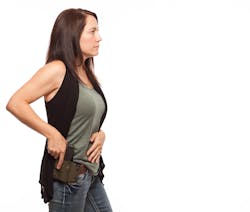What's Your Off-Duty Holster Preference?
Almost every officer in the U.S. (“almost” may be short-changing the reality, it may be EVERY) carries a weapon off-duty. How they choose to carry that weapon, securing it and having it readily available, is often the topic of discussion. Along with the debate about which is the better self-defense cartridge/caliber, the debate about method of carry is probably one of the oldest debates commonly had in the firearms world. To help settle part of the debate about what’s most common (although not necessarily better), we distributed a survey questioning our readership about their preferences in off-duty holsters.
It was a brief survey and we limited the responses to 100 feeling that is a good representative number that can be easily analyzed to change answers to data. The questions covered information about materials, carry locations, mounted lights, optics and caliber of choice. We’ll go through all of the questions and answers but the general overview is this: most officers are carrying a 9mm handgun without any light or optic device in a kydex holster on their belt just behind their strong side hip. Given the plethora of advertising around mounted lights, optics and in-waist band (IWB) holsters, the replies almost seem counter-intuitive. Let’s take a look at the data and make sure our extrapolation is correct.
For off-duty carry, what’s your preference in carry position?
- IWB – appendix = 23.23%
- IWB – behind hip (or farther back) = 33.33%
- IWB – crossdraw = 0%
- OWB (On Waist Band) – strong side or behind = 43.43%
- OWB – crossdraw = 0%
From those answers, it seems that on the waist and at or behind the hip is still preferred. For those folks who like to carry IWB, appendix isn’t as popular as some outlets would have you believe, but the IWB crowd in total accounts for more than half of the respondents. Had we not separated the IWB locations, IWB would have beaten OWB by 12%.
What is your preferred holster material for off-duty holster?
- Kydex = 36.36%
- Leather = 32.32%
- Other “plastic” (polymer, carbon fiber, etc.) = 12.12%
- Hybrid mix of any of the above = 19.19%
One can remember a time when leather was all there was and/or all that was trusted. Kydex came onto the scene in a big way, mostly for its slimness and ease of molding (we’ll see how important that is in just a moment). Now we see that kydex seemed to be preferred, although only just slightly (4%) over leather and hybrid holsters are the third place winners.
What kind of security do you prefer in your off-duty holster?
This question allowed more than one answer which is why, if you add up the percentage of answers you get 118%. Combined, the first two answers—both of which involve a molded holster incorporating some type of friction retention—account for 90% of the responses.
- Molded to provide tight friction = 45%
- Molded but with friction retention incorporated = 45%
- Thumbstrap = 15%
- Internal catch (trigger guard hook, ejection port hook, similar) = 13%
As there may have been some confusion between the first two answers (they do read pretty similar) we’d like to articulate the difference: a holster molded to provide tight friction has no adjustment for retention or friction. The friction retention is created entirely by the shape of the holster as it forms to the shape of the weapon. The specific detail here is that there is no way to increase or decrease the friction. The second option which specifies “with friction retention incorporated” was meant to reflect a holster that has an adjustable friction system (usually a screw you can tighten to make the holster friction increase). While this holster still attributes its security holding the weapon to how well the molded material grips the weapon’s shape, the amount of tension in that grip is adjustable and that was meant to be the focus.
It surprised us that a secondary security method was prioritized so low. A thumbstrap in addition to the molded holster body, whether friction was incorporated or not, was only desired 15% of the time. And an internal catch of any kind only 13%. There are two schools of thought here: first, more security devices means more to defeat when you want your gun out and in your hand RIGHT NOW, and second, there’s more that can malfunction or fail and lock your gun IN the holster when you need it OUT of the holster. If “Keep It Simple Stupid” is the rule of the day, then an open-top friction holster that is molded to secure the weapon is the winner.
Do you have a mounted light on your off-duty weapon?
Again, given the plethora of advertising around such lights and the described absolute need to have one on your handgun (we don’t necessarily agree with that), it was surprising to see the positive responses so low. Only nine percent officers indicated having a mounted light on their off-duty weapon.
- Yes = 9%
- No = 91%
Do you have an optic on your off-duty weapon?
Now, we realize that red-dot / reflex sites are just starting to grow in the industry but we didn’t see a single positive response. It’s our bet that if we run this same survey next year we’d see a growth in positive answers to this question.
- Yes = 0%
- No = 100%
What caliber is your primary off-duty weapon chambered in?
Ten options running from .380ACP to .45ACP were offer along with an “Other” if the reader wanted to specify. (We had one reader select “other” but didn’t specify a caliber.) The caliber options that were offered but that received no responses were: .357 Magnum, .357Sig, 10mm, .44 Special and .44 Magnum. Of the options that did receive responses, 9mm was the most common.
- .380ACP = 3%
- 9mm = 57%
- .38 Special = 2%
- .40S&W = 22%
- .45ACP = 15%
It has often been commented that neither the .380ACP nor the .38 Special have sufficient stopping power to be good defense rounds. That, as with almost everything, is a matter of personal judgment and comfort. Given the dominance of the 9mm round in the duty world, it’s no surprise to see it so dominant in the off-duty world as well. Given the recent, but now seemingly waning, popularity of the .40S&W cartridge in the duty world, to see it prominently represented in the off-duty carry world isn’t surprising. It did somewhat come to a surprise to see the .45ACP still going so strong. 15% may not seem “strong” to some but it’s a significant number when you consider how few agencies carry or authorize that cartridge and the typical size/weight of the weapon needed to carry off-duty for that cartridge.
We may repeat this survey again in the future with some additional options for the various questions. We might add a weapon manufacturer choice, capacity options or other.
About the Author
Lt. Frank Borelli (ret), Editorial Director
Editorial Director
Lt. Frank Borelli is the Editorial Director for the Officer Media Group. Frank brings 20+ years of writing and editing experience in addition to 40 years of law enforcement operations, administration and training experience to the team.
Frank has had numerous books published which are available on Amazon.com, BarnesAndNoble.com, and other major retail outlets.
If you have any comments or questions, you can contact him via email at [email protected].

